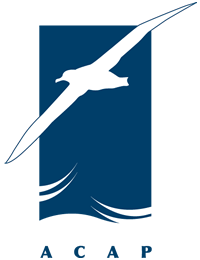
Safe behind a fence and from sea level rise: a Laysan Albatross pair in the Kaena Point Natural Area Reserve in December 2022, photograph by Pacific Rim Conservation
Lindsay Young (Pacific Rim Conservation, Honolulu, Hawaii, USA) and colleagues have published in the journal Pacific Science giving population details collected from 2004 to 2023 for Laysan Phoebastria immutabilis and Black-footed P. nigripes Albatrosses on the Hawaiian island of Oahu.
The paper’s abstract follows:
“Laysan Albatross (Phoebastria immutabilis) fledged the first chick on the island of O‘ahu in 1947, but did not begin regularly breeding until 1992, followed by Black-footed Albatross (P. nigripes) who [sic] began breeding in 2022. Laysan Albatross have attempted to breed at nine locations on O‘ahu since 1979 and have established colonies at four sites: Ka‘ena Point, Kuaokala, Kahuku Point, and James Campbell National Wildlife Refuge. We monitored Laysan Albatross colonies on O‘ahu weekly from 2004 to 2023; all individuals were censused, banded, and identified to gender. There was a population of 875 adults on O‘ahu in 2023, 490 of which were active breeders. The annual growth rate up to 2015 was 26%, but the growth rate slowed to 20% after human vandalism in 2015 that resulted in the destruction of 17 nests and at least 17 adults. The advent of predator exclusion fencing at Ka‘ena Point (2011) and Kuaokala (2021) resulted in increased reproductive success (from 0.37 to 0.43) driven by a 25% increase in chick fledging success (from 0.60 before fencing to 0.80 after) which resulted in an estimated additional 69 chicks fledging compared to if the fence had not been constructed. Black-footed Albatross visits increased to O‘ahu from 3 in 2017 to 317 in 2023, coinciding with the disappearance of East Island in Papahanaumokuakea Marine National Monument which displaced 2,000 breeding pairs. These new colonies are at higher elevations and will continue to serve as refugia against sea level rise and as such, are conservation priorities.
Reference:
Young, L.C., VanderWerf, E.S., Dittmar, E.M., Kohley, R., Goodale, K., Plentovich, S.M. & MacPherson, L. 2024. Status of Laysan and Black-Footed Albatrosses on O‘ahu, Hawai‘i. Pacific Science 78: 103-117.
John Cooper, Emeritus Information Officer, Agreement on the Conservation of Albatrosses and Petrels, 19 December 2024

 English
English  Français
Français  Español
Español